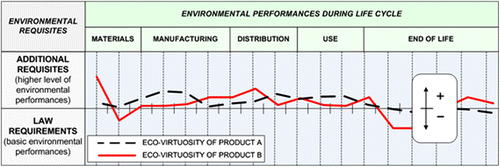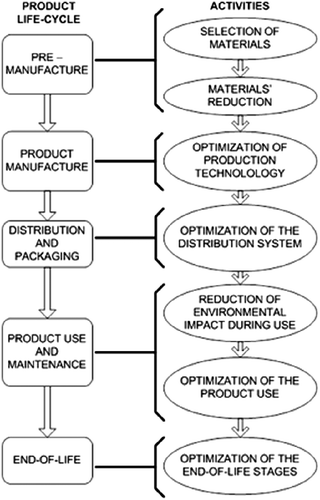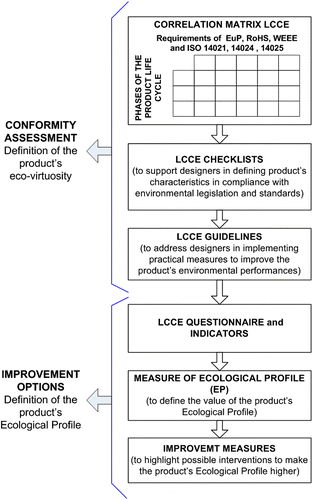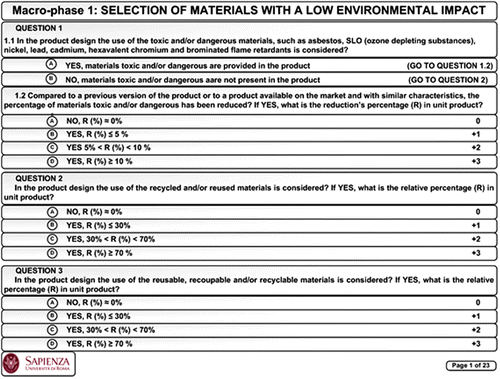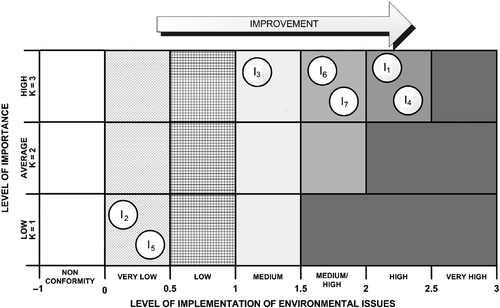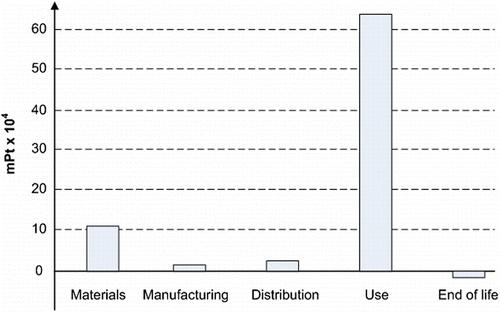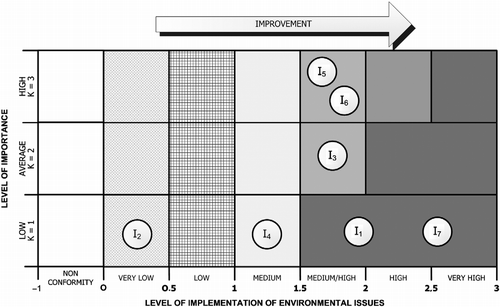Abstract
Customers' awareness of environmental concerns is following an upward trend nowadays, pushing companies to put on the market an ever larger range of ‘green products’. This is also due to the extension of the types of products falling in the scope of environmental legislation (which in European Union requires the new environmental CE (“Conformité Européenne”, i.e. European Conformity) marking for most of industrial products). The research work carried out focuses on the development of a procedure for the definition of the products' ecological profile (EP), making the control and management of their environmental performances affordable also for non-experts. The proposed methodology, named Life Cycle Compliance for Ecodesign (LCCE), allows engineers to evaluate the product's eco-virtuosity, i.e. the environmental improvements over mandatory requisites, taking into account the whole product's life cycle. The methodology was developed throughout the collaboration with manufacturers of different types of products. Results obtained showed that the LCCE methodology resulted in being an easy-to-use ecodesign tool, able not only to manage the conformity of products but also to define the limit of environmental improvements which can be foreseen for the product (i.e. the value over which it is more convenient to re-think the product and its life cycle, rather than upgrading it).
1. Introduction
The evolution of the concept of ‘environmental sustainability’ in recent years has stressed the importance of industrial products' ecological performances. Nowadays, it is clear that most potential for reducing the environmental impact of a product is the prevention, which can be obtained focusing on the design activities, since it is indeed in these stages where the main environmental characteristics of the product and its impact are decided. This approach is also influenced by the ever stricter environmental legislation which has been issued by the European Union (EU), as well as by most developed countries in the last decades.
Moreover, it underlines the increasing popularity among consumers of any product or service, which is called by using the suffix ‘green’ or ‘eco’ (we named this phenomenon the ‘eco-x’ trend), and the ever larger number of environmental labels and declarations in accordance with international standards, which an increasing number of companies adopt as environmental communication tools.
From engineers' perspective, environmental aspects have to be balanced against other factors, such as safety and health, its intended use, performances, cost, marketability, quality and functionality. In such a context, as underlined by the recent standard ISO 14006 (ISO 2011), ecodesign seems to be the most effective tool for achieving this goal. Thus, in product development activities it is fundamental for engineers to assess the level of environmental compliance of products since the first stages of the ecodesign process. In other words, the product's behaviour along its life cycle with respect to environmental legislation can be considered as a product's property (which we call ‘eco-virtuosity’): its understanding allows designers to shift from control to management of ecodesign activity, increasing their awareness about the environmental issues while designing. The presented research work is focused on the definition of a methodology to assess such a property, which can be used within the traditional ecodesign framework, to establish the ecological profile (EP) of industrial products in compliance with latest EU environmental regulations, and to make the improvement of product's environmental performances easier. The validation of this approach was performed by means of a collaboration with manufacturers of different types of industrial products.
In detail, the present paper is structured as follows: in Section 2, a general review of the latest achievements in the field of sustainable product development is presented, pointing out the role of environmental legislation, as well as the concept of eco-virtuosity. Then, in Section 3, the research approach is discussed, and in Section 4, the developed methodology, which we called Life Cycle Compliance for Ecodesign (LCCE), is proposed. In Section 5, case studies, which allowed us to set the methodology, are summarised, showing the usability of LCCE in ecodesign activities. Thus, in Section 6, the discussion of results and conclusions are presented.
2. Background and motivations
Environmentally conscious design (or ecodesign) represents one of the most widespread and effective approaches for product development, aimed at giving an answer to the industrial world regarding the ever growing environmental and social pressure, and responsibility of today's society. Each stage of the product's life cycle has an effect on the environment, which may be low or significant, of a short-term or long-term duration. The relevance of such a simple statement has been generally recognised in the last decades, as well as being underlined by the great attention paid by customers, users, product developers and all stakeholders involved in the environmental aspects and effects of products. Actually, the shift from the ‘end-of-pipe’ approach (focused on interventions of protection) to the concept of sustainable development (based on preventive interventions) can be carried out involving all actors that concur or are involved in the product's life cycle. As argued by many authors who have investigated the relationships among all stakeholders entangled with environmental product development activities (Dewulf and Duflou Citation2005, Boks Citation2006, Lindhal et al. Citation2007), ecodesign activities need to be integrated within company's operations and strategies.
Different studies in literature (e.g. Roy and Vezina Citation2001, Stevels Citation2005, Orsato Citation2006, Bresciani and Oliveira Citation2007) show that the number of companies that adopt environmental communication tools and strategies (such as corporate environmental reports, eco-label and eco-declarations projects and environmental management systems) is constantly increasing, since a competitive advantage through environmental differentiation can be achieved.
The importance of ecodesign has been recently stressed by the issue of the ISO Citation14006:2011 standard, which underlines the benefits of conducting ecodesign (Section 4), as well as the importance of identifying applicable legal and other requirements in product design and development activities (Section 5).
In such a context, one of the most significant problems concerns the need to optimise the integration of product development activities together with the requirements of environmental mandatory regulations. In fact, in recent years, in most industrialised countries a series of environmental regulations have been issued by local governments, following the request of the United Nations and other organisations, aimed at introducing stricter environmental policies in the industrial world.
2.1 Environmental legislation
Considering the situation in the EU, following the principles issued in the European Community Constitution, which promotes a common policy aimed at preserving the environment and fostering the sustainable development of the community (EU Citation2004), the actions carried out in the field of environmental legislation have become ever increasing and detailed. Driven by the so-called New Approach regarding the way of issuing laws and regulation at the community level (e.g. the new directives concerning safety starting from the beginning of 1990s), recent interventions made a breakthrough in the field of development and production of industrial products.
In particular, the Integrated Product Policy (IPP) put forward a change from the so-called end-of pipe approach to the more efficient and effective ‘front-of-pipe’ one throughout the implementation of ‘Life Cycle Thinking’ strategies (Charter et al. Citation2001, Nuij Citation2001).
In Table , recent issues of the EU in this field are schematised, based on the ‘Green Paper on the Integrated Product Policy’ (EC Citation2001), where a set of rules of a general nature, which product developers should follow in order to obtain more eco-efficient products, was proposed.
Table 1 Latest environmental directives affecting most of industrial products.
Needless to say, the interventions of the European Union mentioned in Table cannot be considered as comprehensive, but only related to the most significant environmental rules for the development of industrial products. At the same time, also numerous other countries extra EU have issued similar environmental precepts (e.g. Canada, USA, Japan and South Korea). Among the above, the Directive 2009/125/EC seems to represent the most considerable novelty in the field. Actually, this directive shifted from ‘energy-using products’ (EuP) directive (EU 2005) to ‘energy related products’ (ErP) directive.
It is also important to underline the introduction of a mandatory CE (Conformité Européenne) conformity mark (similar to the one used in the field of machine safety) to certify that the product has met EU ‘essential requirements’ from environmental point of view. The CE marking is now mandatory in accordance with both the ErP and the RoHS (Restriction of Hazardous Substances) directives, and probably it will be included also in the new WEEE (Waste Electrical and Electronic Equipment) directive.
Concluding this overview on the environmental legislation, it comes out that nowadays most of the industrial products on the market have received a certain improvement from the environmental point of view because of legal obligation and/or customer expectation. Since the number of categories of products under the scope of environmental directives is becoming constantly larger, it is clear that basic environmental characteristics are mandatory for all the products of the same type put on the market. Thus, the effort made for increasing the level of the environmental sustainability of products should be seen as an improvement over these minimum environmental standards requested by the legislation.
2.2 The concept of eco-virtuosity
The increasing popularity among consumers of what we can call the ‘eco-x’ trend (as explained in Section 1) has caused the necessity for companies to push on the ‘greening process’ of their activities and outputs. Hence, considering whether a product can be defined ‘eco’ or not has not become clear because of its dependency on the perspective of the observers.
On the one hand, if a product belongs to one of the categories under the scope of environmental directives, it is clear that the law defines basic environmental characteristics, and they are mandatory for all the products of the same type. Thus, this fact only assures the compliance of the product with legal obligations, which can be felt as an environmentally friendly aspect from customers' point of view. From this perspective, all products are somehow ‘eco’ or ‘green’, but in terms of environmental performances all products can be considered at the same level.
On the other hand, some companies might want to increase the level of the product's environmental performances over the minimum environmental standards requested by EU legislation. In this case, from engineers' perspective, the product can be considered ‘greener’ or more environmentally friendly, because its environmental performances are higher than standard ones. Such a property (i.e. the level of a product's environmental performances over the requisites defined by the law) was defined ‘eco-virtuosity’ (Fargnoli et al. Citation2010b). In Figure , the eco-virtuosity of two different products is shown.
Companies can certainly make a distinctive value by implementing environmental measures over the mandatory requisites, which customer can perceive and prefer. Such a competitive differentiation, in terms of green attributes of a product or service over mandatory requisites, needs to be clear and ease to understand for customers. As noted by Wong et al. (Citation1996), there is the risk of mis-specification of green products in relation to consumers' needs, as well as there are barriers for customers to perceive green products' environmental performances.
From engineers' point of view, in accordance with the above definition, the level of eco-virtuosity of a product can be positive or negative, depending on its behaviour with respect to its life cycle. Moreover, the eco-virtuosity of a product can be different depending on the market (e.g. EU market and US market), since environmental legislation might require different standards. At the same time, we should also consider the level of eco-virtuosity from the time perspective: law requisites are continuously improved, so that the level of eco-virtuosity needs to be considered as a dynamic parameter.
Thus, mandatory requisites of environmental directives push companies in taking into account ecodesign issues. The estimation of the compliance with environmental legislation certainly requires a significant effort by companies, because of both the novelty of the approach introduced by the EU, which requires a radical change from the previous ‘end-of-pipe’ solutions, and the lack of specific instructions (e.g. case studies) provided by institutions for making the application of such regulations simpler, especially for small- and medium-sized companies (SMEs). In fact, in spite of the large number of tools developed focusing the attention on the improvement of environmental performances of products (e.g. Wimmer et al. Citation2005, Bygget and Hochschorner Citation2006, Lofthouse Citation2006, Pigosso et al. Citation2010), only a restricted number of companies can afford to adopt a proper ecodesign approach suitable for the real needs of the company (Prudhomme 2003, Borchardt Citation2009). In other cases, even a correct application of environmental policies by the company's management resulted in being less effective than expected, due to operative difficulties in using information and tools concerning design activities, as emerged from the experience achieved in carrying out the present research work.
All things considered, there is a need to translate mandatory requisites of environmental legislation into useful inputs for the development and management of industrial products, in order to integrate them correctly into ecodesign activities. The research work, started in 2008 (Fargnoli et al. Citation2008), was focused on reducing the gap between conformity needs and improvement opportunities, giving an answer to the question: ‘how to combine ecodesign issues with environmental mandatory requisites?’.
3. Research approach
On the basis of these considerations, the research focused on the development of a methodology for the assessment and the improvement of the EP of industrial products taking into account the compliance with the environmental legislation, considering their whole life cycle. Indeed, since the introduction of directive EuP, the relevance of specifying the EP of a product in its documentation has emerged. Moreover, a clear communication of this to customers is foreseen (it has to be noted that the before mentioned EuP directive explicitly required that ‘on the basis of this assessment manufacturers will establish its ecological profile’; such an issue can be found also in the recast of EuP, i.e. in Annex I, part 3, of the ErP directive). Bearing all these in mind, the research work proposes an ecodesign approach aimed at taking into consideration regulations' requirements, augmenting the traditional approaches, which are mainly based on considering as input data concerning energy consumption and emissions.
For this purpose, the definition of the methodology was based on the framework of ecodesign activities proposed by ISO/TR 14062 (ISO 2002), which underlines both the importance of considering environmental aspects during the whole product's life cycle and the activities needed to improve the product development activities, providing guidelines for the integration of environmental features into the design and development stages of the product. As for the environmental performances of products, the attention was focused on the environmental aspects that affect the various stages of the whole product's life cycle.
With this aim in mind, a general scheme, divided into seven main phases, was developed. Each phase was merged with the main activities aimed at improving the product's environmental performances. In Figure the following ‘macro-phases’ are shown:
| • | Pre-manufacture phase includes both selection of materials with low environmental impact and reduction of materials.
| ||||
| • | Product manufacture phase focuses on the optimisation of production technologies. | ||||
| • | Distribution and packaging are linked with activities concerning optimisation of the distribution system. | ||||
| • | Product use and maintenance stages include both reduction of environmental impact during use and optimisation of product life cycle. | ||||
| • | Disposal stage concerns the optimisation of the end-of-life management system. | ||||
4. The LCCE assessment methodology
The methodology proposed is based on the integration of different tools developed in order to match the different stages of products' life cycle and both mandatory and voluntary requirements. Actually, requisites of EuP, RoHS and WEEE directives, as well as requisites of products' environmental labelling and declarations (ISO Citation14021:1999, ISO Citation14024:1999, ISO Citation14025:2006), were taken into account, following both a bottom-up and a top-down approach (Park et al. Citation2006). In order to better define the relationships among the above requisites, assessment criteria were developed, based on a set of specific indicators for the estimation of the EP of a product.
The use of these tools follows the various stages of the design process, and it is to be intended as mainly dedicated to the first stages, i.e. planning and conceptual design. Nevertheless, an application at different design stages can also be foreseen, depending on both the nature of the product which is analysed, and the results expected by the application of the methodology. In detail, the tools developed are the followings:
| 1. | LCCE Correlation Matrix; | ||||
| 2. | LCCE Checklist; | ||||
| 3. | LCCE Guidelines; | ||||
| 4. | LCCE Questionnaire; | ||||
| 5. | LCCE Indicators. | ||||
4.1 LCCE Correlation Matrix
The LCCE Correlation Matrix is aimed at defining relationships between the different sub-stages of the product's life cycle and the environmental regulations and standards. In other words, such a tool helps the design team to better understand at which stages of the life cycle the requirements arising from environmental legislation (and standards) influence the product design. It supports actions aimed at developing a product that meet the requirements and anticipates the actions to achieve a labelling or environmental declaration since the earliest stages of the design process.
4.2 LCCE Checklists
In order to support engineers in implementing the LCCE Matrix, a series of checklists were developed. To be precise, for each macro-activity a checklist was defined, containing the details of the correlation between sub-phase and guideline and/or voluntary standards, with explanations regarding the existence of that relationship.
4.3 LCCE Guidelines
LCCE Correlation Matrix and the various LCCE Checklists support engineers in identifying the various regulatory, mandatory and voluntary requirements, which must be taken into account at each stage of the product's life cycle. Actually, improving product's eco-friendliness level and at the same time meeting the requisites of environmental regulation are quite difficult to perform, e.g. by coordinating and implementing these aspects in the design process in a coherent and feasible way. This is particularly true for SMEs, which have difficulties in correctly assessing the impact of their activities on the environment, or have to make a great effort in taking into account environmental legislation. For these reasons, easy-to-use guidelines aimed at providing practical instructions for the use of the LCCE Checklists, and thus of the LCCE matrix, were developed.
4.4 LCCE Questionnaire
The core of the methodology consists in the assessment phase, e.g. quantify the product's eco-friendliness level through a self-evaluation of the activities carried out by the company and regarding the whole life cycle of the product. Such a goal was achieved by developing a specific questionnaire.
The effectiveness of questionnaires to assess ecodesign issues is affirmed by many authors (Brezet and Hemel Citation1997, Yarwood and Eagan Citation1998, Lindahl and Tingström Citation2000, JEMAI Citation2001, Wimmer and Züst Citation2003).
The proposed questionnaire concerns decisions made by the company about product development and management from an environmental point of view (an excerpt of the questionnaire is shown in Figure ) with the focus on regulations. It has to be noted that the questionnaire is composed by two main parts: a general framework, suitable for all companies, and an additional part dedicated to the specific product analysed. This means that not all the questions in the questionnaire are suitable to every product, as explained in the following paragraphs.
4.5 LCCE Indicators
The questionnaire reproduces the pattern of the product's life cycle, which was divided into seven main sections corresponding to the following macro-activities:
| • | Materials selection; | ||||
| • | Materials reduction; | ||||
| • | Optimisation of production; | ||||
| • | Optimisation of distribution; | ||||
| • | Reduction of the impact during use; | ||||
| • | Optimisation of the use phase; | ||||
| • | Optimisation of the disposal phase. | ||||
4.6 The measure of the product's EP
Regarding the scoring appointed to the various sub-indicators and indicators, an objective assessment has been pursued, aiming primarily at the uniformity and homogeneity of the approach for each individual question. The pattern of scoring is as follows. For each question: the highest score is +3 and the minimum score is − 1 or 0, depending on whether the response is associated with a breach of environmental legislation. Where more than one answer is allowed, to each alternative a score of +3 divided by the number of alternatives provided is associated. If the question is divided into sub-questions, the maximum value +3 is derived from the sum of the contributions of each sub-question. For each macro-activity, the score is calculated using the following formula in order to get a normalised score:
In short, the EP of the product will be given by using the following equation:
The assessment and control system were developed taking into account the recent approaches in the use of indicators for the improvement of company performances, as the one shown in Parmenter (Citation2007). With this aim in mind, the main characteristics of the evaluation system which we tried to develop are based on the following assumptions:
| • | The system should be complete, i.e. able to take into account all environmental aspects which might affect the environmental performances of the product. | ||||
| • | Indicators assess designers' decision making and, at the same time, support them in critical choices. | ||||
| • | The system is flexible and can be adapted for the analysis of different scenarios. | ||||
| • | The system is easy to understand and easy to use, allowing also technicians with a low experience in the environmental field to carry out meaningful and useful results. | ||||
The level of importance of each macro-activity is defined case-by-case by the design team, depending on the results derived from an all-embracing study of the product. Key factors to take into account are the type of product and the strategy pursued by the company regarding its production (e.g. mission, goals and corporate policies).
In the proposed case studies, a multi-criteria reference scheme (see Table ) was handed into a team in the company, which by consensus decided the level of importance for every macro-activity. The reference scheme is to intend as a suggestion taking into account competitiveness opportunities (market and benchmark) and risks (compliance controls and potential losses), but it is to be intended just like an example.
Table 2 Example of reference scheme for the levels of importance.
4.7 The map of indicators and the eco-friendliness level
The first step towards the overall assessment of the product's EP is the definition of a map of the indicators. The idea is to set up an easy-to-read representation of the environmental situation assessed for the product. Thus, a synthesis of the levels of importance and the level of indicators is showed in the example scheme of Figure . Each indicator I i represents the corresponding macro-activity and is placed in the cell identified by the right combination of two items: level of importance of macro-activity (K i ) and level of implementation of environmental issues in that macro-activity. It is clear for the producer that the environmental improvements of the product should focus on macro-activity in the upper-left part of the scheme, where the importance is high and the improvements are available (with the increase in the level of indicators). On the contrary, the macro-activities in the upper-right part have no capability to improve their level of environmental compliance, so it should be only monitored. For macro-activities in the middle or lower part, the considerations are similar but with less effect.
Downstream of the mapping of the LCCE Indicators, varying from product to product, the maximum value achievable for the EP is defined as the result of Equation (Equation3):
Once the value of EPmax has been calculated, this represents the tip of the highest band in the evaluation of the EP. Since the product EP is in the interval [0, EPmax] this range is divided into five sub-intervals of the same range, which represent the bands of eco-friendliness level, i.e. bands characterised by the same value of the EP. In other words, depending on the range in which the real EP of the product is placed, an easy-to-understand environmental assessment of the product in terms of eco-friendliness level is provided.
5. Implementation of the LCEE methodology
In order to optimise the assessment procedure and to test its effectiveness, the collaboration with companies was needed. As mentioned above, two case studies allowed us to complete the procedure and analyse its weak points. For this purpose, two products with a low level of complexity were selected, taking into account the following aspects:
| 1. | Companies were chosen with the support of an Italian non-governmental environmental organisation, officially recognised by the Italian Ministry for Environment, which selects companies whose products are considered ‘green’ (Legambiente Citation2010); | ||||
| 2. | In both cases, manufacturers were very interested in testing the environmental performances (i.e. the real EP) of their products, and were willing to obtain or upgrade an environmental declaration/label according to ISO standards. | ||||
Then, after a review of the contents of LCEE methodology based on suggestions and comments emerged by the previous studies, a further application was performed to assess the EP of a more complex product, falling into the scope of the above-mentioned RoHS, WEEE and EuP directives.
5.1 Case study 1: insulation panel
From a preliminary analysis it emerged that company's management is willing to obtain a manufacturing process with a low environmental impact and a product that is eco-friendliness, as well as meeting the latest law requirements in the field of thermal insulation in buildings. Moreover, there is a CE mark in accordance with the obligations imposed by Directive 89/106/EC and the harmonised European standard EN 13164:2008. Regarding the product object of the analysis, its main characteristics are the following:
| • | straight edge; | ||||
| • | smooth surface; | ||||
| • | thickness (40 mm); | ||||
| • | length (1250 mm); | ||||
| • | width (600 mm). | ||||
In detail, strengths of the product's eco-friendliness level are represented by macro-activities 5 (thanks to the use of CO2 in manufacturing process) and 6 (because of the main features of the panel such as high reliability, modularity and simple installation). In addition to these, a high level of importance (K = 3) regarding the type of product examined and related to its market strategy was assigned. Regarding macro-activities 1 (selection of materials) and 4 (packaging and distribution), a high level of implementation of environmental issues was found. Macro-activity 7 (disposal) is characterised by an average level of implementation of environmental issues and a high level of importance assigned by the company.
Macro-activities 2 and 3 have received a low level of implementation of environmental issues, due to the specific characteristics of the product: the insulation provided by the panel is directly proportional to its thickness, hence, the inability to take action to reduce volume and therefore weight of the product. A possible improvement consists in the reduction in the variety of materials. It emerged as fundamental to reduce energy consumption and promote renewable sources, as well as non-essential materials used in production, first of all the colour. Once the maximum ecological profile (EPmax) was calculated and the eco-friendliness levels were defined, it was possible to define the real EP value, which resulted being equal to 1.81, thus belonging to the category of products with an eco-friendliness level of 75%.
To better explain the calculation process, the indicator I 1 correspondent to the macro-activity 1 is composed by six sub-indicators. Thus, the questionnaire has six specific questions, one for every sub-indicator and the answer is chosen from a 4-level scale linked to the specific score (see Figure ). The results from the questionnaire in the case study of the insulation panel are presented in Table . It has to be underlined that the score of some sub-indicators is obtained by multiple questions; for this reason, when the average value is calculated for the specific SI, it is possible to obtain a value that is not a whole number.
Table 3 Scores for the Case study 1 – insulation panel.
The EPmax is calculated considering the best value available for every fitting answer: some of them can be evaluated equal to zero when they are not related to the product (e.g. energy consumption during the use or disposal requirements for electrical and electronic equipment) (Table ).
Table 4 Eco-friendliness level for the Case study 1 – insulation panel.
5.2 Case study 2: cooking pan
The product analysed is produced with a high percentage of recycled materials (e.g. aluminium), as well as materials that reduce the environmental impact (e.g. handle made by bamboo). The main results of the application of the LCCE methodology brought to light the weakest aspects concerning the implementation of environmental issues in macro-activities are the ones related with indicators I 3, I 6 and I 7 (see Figure ).
In detail, regarding indicators I 1 and I 4, they already reached high levels. As far as macro-activities 2 and 5 are concerned, a significant effort is needed in order to improve their performances from the environmental point of view: in particular, in macro-activity 2 a reduction in materials in weight and/or volume is foreseen. Moreover, a further reduction in materials, types and colours might positively affect also macro-activity 5. Company's strengths in terms of eco-friendliness level are identified in the macro-activities 1 and 4, and then in the indicators I 1 and I 4 with a high level of implementation of environmental aspects. In particular, within the macro-activity 1, the company's choice to invest in materials free of hazardous substances (e.g. non-stick perfluorooctanoic acid free), recycled (aluminium), natural (bamboo) and 100% recyclable (aluminium and bamboo) materials resulted in being very effective. Possible further actions aimed at improving this macro-activity can be represented by the following interventions:
| • | preserving the non-toxic and non-hazardous materials; | ||||
| • | strengthening the approach to reducing and preventing waste by facilitating the transformation; | ||||
| • | moving towards self-sufficiency in terms of disposal plants. | ||||
| • | providing more detailed information to suppliers for the production of the handles; | ||||
| • | in the case of purchasing pre-painted aluminium discs from the third parties, verifying the eco-efficiency of their production (e.g. the presence of environmental certificates); | ||||
| • | continuously monitoring the noise level in the workplace; | ||||
| • | reducing waste and implementing separate collection of waste. | ||||
5.3 Case study 3: dishwasher
Results obtained in these case studies can be considered positive: in fact, the LCCE methodology resulted in being very effective in
| • | the verification of the compliance with EU environmental directives; | ||||
| • | the evaluation of the EP of products; | ||||
| • | finding out possible improvements of environmental performances of the product. | ||||
The procedure is based on the use of a relationship matrix and allows the definition of a complete study of all possible alternatives that emerged from the analysis. In addition, the possibility of checking the compliance with most common standards regarding environmental labels and declarations allows the procedure to be used for the product's certification, as well as for the certificate maintenance (e.g. as a tool for performing audits). On the other hand, some weak points also emerged: in particular the assessment of the level of importance of macro-activity (K i ) was considered too much related with the experience of engineers who are performing the assessment, influencing subjectively the assessment of the indicators.
Then, the effectiveness of the assessment procedure was verified by applying the LCCE methodology to the analysis of a dishwasher. In detail, the main characteristics of the machine taken into account are the following:
| • | dishwasher for household use (maximum 14 place settings, 60 cm width, free standing, orbital spray system); | ||||
| • | environmental parameters assessed in accordance with the EN 50242 (BS EN Citation60436:2008) standard (water, 12 l; energy, 0.98 kWh; energy efficiency, A; washing performance, A; drying performance, A; noise level, 43 dB(A); nominal power, 1.90 kW). | ||||
The use of LCA showed that the higher impact concerns the use phase, as it could be foreseen considering the type of product (large use of water and energy). The LCCE methodology confirms this fact, since both indicators related with the use phase (I 5 and I 6) have a higher level of importance. At the same time, the definition of the EP (Figure ) allowed us to understand how much the product can be improved in order to reduce its impact on environment, and which are its life cycle phases that show the most suitable opportunities for these improvements. In Figure , it is shown that the maximum value of indicator I 7 exceeds the maximum value because it does not represent the maximum level available but, considering the importance of macro-activity (K 7), the maximum required. Thus, the methodology shows that the organisation focused on the improving of an aspect, overcoming the requirements.
Figure 9 Comparison between real values and maximum ones for the indicators (Case study 3: dishwasher).
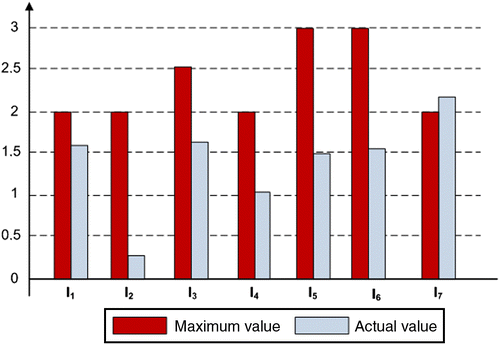
As far as the proper moment of application (during product design and development activities) of the LCCE methodology is concerned, the specific needs of the company have to be taken into account. In general, the application during first stages (planning and conceptual design) certainly allows engineers to obtain more useful results, especially if used in synergy with other ecodesign tools, such as Ecodesign PILOT (Wimmer and Züst Citation2003) and Quality Function Deployment for Environment (Sakao Citation2007). For instance, in the first case, the LCCE methodology can increase the effectiveness of Ecodesign PILOT, assuring a dynamic control and management of the product compliance with mandatory and voluntary requisites. In the latter context, the proposed methodology can be used as an input for the Quality Function Deployment for Environment (QFDE) method. Moreover, in order to make the assessment procedure as much objective as possible, the use of the Analytic Hierarchy Process (AHP) method (Saaty Citation2008) was foreseen.
6. Conclusions
Early identification and planning of the product's environmental profile enable engineers to make effective decisions about environmental aspects of its whole life cycle. This also allows them to control and manage the effects of environmental aspects that affect (or may affect) other stakeholders. The research focused on the development of a methodology for the assessment and the improvement of the EP of industrial products, taking into account their whole life cycle and the compliance with the environmental legislation and standards. The output consisted of an ecodesign methodology for the evaluation of environmental performances of the products life cycle, able to support engineers controlling and managing the compliance with environmental regulations.
Compared with existing assessment tools for ecodesign, the proposed methodology presents the following characteristics:
| • | it is focused on the verification of product's conformity with environmental legislation and the achievement of the environmental CE mark; | ||||
| • | it is based on a self-assessment procedure quite management oriented, which can be supportive in implementing and maintaining a company management system, or an environmental product label/declaration; | ||||
| • | it makes the evidence of ‘eco-virtuosity’ aspects (i.e. environmental performances over mandatory requisites) easier, which can be communicated to both customers and other stakeholders clearer; | ||||
| • | the measurement of the EPmax, can be helpful in defining the limit of environmental improvements which can be foreseen for the product (i.e. the value over which it is more convenient to re-think the product and its life cycle, rather than upgrading it). | ||||
The research work is currently in progress: the proposed approach, just updated with latest amendments of the environmental directives, is going to be applied to other case studies in order to optimise its use, enlarging the number of indicators and making the scoring system more objective, i.e. not depending on the person who carries out the analysis. Moreover, with the aim of improving its efficiency and making it more user-friendly, the implementation of the procedure in software is foreseen.
References
- Boks , C. 2006 . The soft side of ecodesign . Journal of Cleaner Production , 14 ( 15–16 ) : 1346 – 1356 .
- Borchardt , M. 2009 . “ Assessment of the importance and application of ecodesign practices: a survey in companies of the furniture industry ” . In Proceedings of EcoDesign 2009 7–9 December, Sapporo, Japan [CD-ROM]
- Bresciani , S. and Oliveira , N. 2007 . Corporate environmental strategy: a must in the new millennium . International Journal of Business Environment , 1 ( 4 ) : 488 – 501 .
- Brezet, H., and Hemel, C.V., 1997. Ecodesign: promising approach to sustainable production and consumption. UNEP. Paris: United Nations Publications
- Bygget , S. and Hochschorner , E. 2006 . Handling trade-offs in Ecodesign tools for sustainable product development and procurement . Journal Cleaner Production , 14 : 1420 – 1430 .
- Charter , M. 2001 . Integrated product policy and eco-product development , Sheffield, UK : Greenleaf Publishing .
- Dewulf , W. and Duflou , J. 2005 . Integrating ecodesign into business environments: a multi-level approach . : 55 – 76 . D. Talaba & T. Roche, eds. Product Engineering. Dordrecht: Springer Science + Business Media, Inc.
- EC, 2001. Green Paper on Integrated Product Policy. COM(2001)68, 7 February. Brussels
- EN 50242:2008, EN 60436:2008, Electric dishwashers for household use. Methods for measuring the performance
- EU, 2004. Treaty establishing a Constitution for Europe. Section 5, http://europa.eu/constitution/index_en.htm
- EU, 2005. DIRECTIVE 2005/32/EC of 6 July 2005 establishing a framework for the setting of ecodesign requirements for energy-using products and amending Council Directive 92/42/EEC and Directives 96/57/EC and 2000/55/EC of the European Parliament and of the Council
- Fargnoli , M. 2010b . “ Eco-virtuosity: management of Ecodesign issues ” . In Proceedings of DESIGN 2010 17–20 May, Dubrovnik, Croatia
- Fargnoli , M. 2008 . “ Environmental regulations in life cycle design activities ” . In Proceedings of EGG Care Innovation 2008 7–10 September, Berlin, Germany
- ISIS, 2007. Preparatory Studies for eco-design requirements of EuPs, LOT 14: domestic washing machines and dishwashers. www.ecowet-domestic.org
- ISO 14006:2011, Environmental management systems – guidelines for incorporating ecodesign
- ISO 14021:1999, Environmental labels and declarations – self declared environmental claims, Type II environmental labelling
- ISO 14024:1999, Environmental labels and declarations – type I environmental labelling – principles and procedures
- ISO 14025:2006, Environmental labels and declarations – type III environmental declarations – principles and procedures
- ISO/TR 14062:2002, Environmental management – integrating environmental aspects into product design and development
- JEMAI, 2001. Study on the introduction and promotion of environmentally conscious business activities. The Japan Environmental Management Association for Industry http://www.jemai.or.jp/
- JEMAI, 2004. Eco-efficiency indicator – handbook for products. The Japan Environmental Management Association for Industry, http://www.jemai.or.jp/
- Legambiente, 2010. http://www.legambiente.it/legambiente/prodotti-sostenibili-consigliati (in Italian)
- Lindahl , M. 2007 . “ Integrated product and service engineering versus design for environment – a comparison and evaluation of advantages and disadvantages ” . In Advances in Life Cycle Engineering for Sustainable Manufacturing Businesses , Edited by: Takata , S. and Umeda , Y. 137 – 142 . Berlin : Springer-Verlag . 2 (A5)
- Lindahl , M. and Tingström , J. 2000 . A small textbook on environmental effect analysis , Kalmar : Department of Technology, University of Kalmar .
- Lofthouse , V. 2006 . Ecodesign tools for designers: defining the requirements . Journal Cleaner Production , 14 : 1386 – 1395 .
- Nuij , R. 2001 . Eco-innovation: helped or hindered by Integrated Product Policy . The Journal of Sustainable Product Design , 1 : 49 – 51 .
- Orsato , R. 2006 . Competitive environmental strategies: when does it pay to be green . California Management Review , 48 ( 2 ) : 127 – 143 .
- Park , P.-J. , Lee , K-M. and Wimmer , W. 2006 . Development of an environmental assessment method for consumer electronics by combining top-down and bottom-up approaches . The International Journal of Life Cycle Assessment , 11 ( 4 ) : 254 – 264 .
- Parmenter , D. 2007 . Key performance indicators (KPI): developing, implementing and using winning KPIs , Hoboken, NJ : John Wiley and Sons .
- Pigosso , D. 2010 . Ecodesign methods focused on remanufacturing . Journal of Cleaner Production , 18 ( 1 ) : 21 – 31 .
- PRé Consultants, 2008. SimaPro database manual – methods library. PRè Consultants bv. Amersfoort. The Netherlands
- Roy , M.J. and Vezina , R. 2001 . Environmental performance as a basis for competitive strategy: opportunities and threats . Journal of Corporate Environmental Strategy , 8 ( 4 ) : 339 – 347 .
- Saaty , T.L. 2008 . Decision making with the analytic hierarchy process . International Journal of Services Sciences , 1 ( 1 ) : 83 – 98 .
- Sakao , T. 2007 . A QFD-centred design methodology for environmentally conscious product design . International Journal of Production Research , 45 ( 18-19 ) : 4143 – 4162 .
- Stevels , A. 2005 . “ Traditional EcoDesign in proactive electronic companies will be soon dead! Long live Ecovalue! ” . In Proceedings of International Conference Towards Sustainable Product Design Farnham, UK
- Wimmer , W. and Züst , R. 2003 . Ecodesign PILOT, product-investigation, learning- and optimization-tool for sustainable product development with CD-ROM , Dordrecht : Kluwer .
- Wimmer , W. 2005 . “ Ecodesign in twelve steps ” . In Proceedings of ICED 05 15–18 August, Melbourne, Australia
- Wong , V. , Turner , W. and Stoneman , P. 1996 . Marketing strategies and market prospects for environmentally - friendly consumer products . British Journal of Management , 7 : 263 – 281 .
- Yarwood , J.M. and Eagan , P.D. 1998 . Design for Environment Toolkit: a competitive edge for the future , Saint Paul, MN : Minnesota Office of Environmental Assistance .
